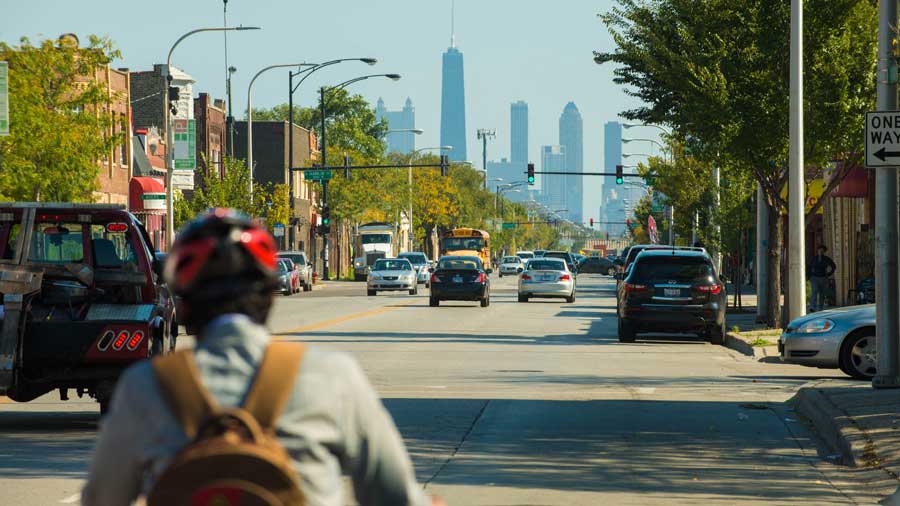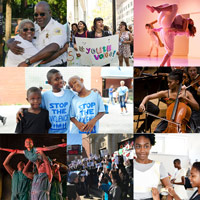Tara Magner, Director, Chicago Commitment shares how we are refining and focusing our strategy in Chicago to help us achieve greater impact.
While Chicago has long experienced racial injustice, the COVID-19 pandemic affected Chicago’s Black and Latina/o/x communities at much higher rates than other populations and brought heightened attention to the inequities many Chicagoans have endured for generations. Moreover, the police killings of Black Americans such as George Floyd and Breonna Taylor and the related civil unrest prompted us to re-examine our grantmaking priorities and adjust them to meet the moment.
Since its launch in 2016, MacArthur’s Chicago Commitment team has invested in people, places, and partnerships to advance racial equity and build a more inclusive Chicago. We developed our grantmaking priorities in collaboration with Chicagoans, striving to address what residents and civic leaders across the city told us was most important to them.

The strategy we developed focuses on three key areas in Chicago: Civic Partnerships; Culture, Equity, and the Arts; and Vital Communities. In addition, we strive towards Advancing Leadership across all of our work.
Consistent with the Foundation’s periodic review and refinement of grantmaking strategies, over the past 18 months, we examined our Chicago Commitment strategy to ensure that our work directly contributes to building an equitable, vital, and dynamic Chicago. The assessment of our program showed strong and intentional values alignment and identified opportunities and demand to advance racial equity in the region. A key takeaway was that while we have made progress toward short-term outcomes, the overall goal of advancing racial equity takes time and is often incremental.
With this in mind, we have begun work to refine and focus our strategy in ways that we believe will help us achieve greater impact in partnership with grant recipients, manifest our values and our commitment to the Just Imperative, and work in closer relationship with communities.
Refining for Greater Impact
Specifically, we will narrow the geographic footprint of our Vital Communities grantmaking to amplify our impact. This will help harmonize our approaches in ways that are mutually reinforcing. For example, since 2016, we have supported efforts to reduce gun violence in nearly two dozen neighborhoods in Chicago and also invested in place-based economic development in approximately 15 communities. There was considerable overlap in those two sets of locations, but we saw that our funds were spread too thinly to achieve our goals on equity. Focusing our work will enable us to deepen community partnerships, strengthen the capacity of organizations, and pursue greater cohesion across our approaches. We believe that increasing our investments in a smaller number of communities will contribute to improved quality of life and greater racial equity and inclusion, in a tangible way.
Refining our strategy is an opportunity to address systemic inequity and strengthen communities for sustained change.
In determining where we will invest in place-based economic development, our team analyzed an array of different indicators related to Chicago neighborhoods, including levels of community engagement, income and wealth, demographic shifts, public safety, and the history of investment and/or disinvestment, among others. This process led us to focus our future economic development grantmaking in these neighborhoods:
- Austin
- Belmont Cragin
- Gage Park
- Greater Garfield Park (East Garfield Park and West Garfield Park)
- Greater Englewood (West Englewood and Englewood)
- Greater Roseland (Roseland and West Pullman)
- Humboldt Park
- North Lawndale
- South Lawndale/Little Village
- South Shore

View accessible version of map data ›
For neighborhoods where we have previously offered place-based economic development grants, that are not included in the future ten, we will work through this transition with grant recipients, offering multi-year tie-off awards. Going forward, to select grant recipients in the ten neighborhoods where we will offer place-based economic development grants, we will rely on the advice of external nominators to help us determine which organizations are highly effective, are rooted in the communities they serve, and are closely aligned with our grant guidelines. The use of external nominators is a practice we have used in the past to select Vital Communities grants recipients. It introduces us to organizations with which we may not have worked previously. This tradition is similar to our practice of consulting with external advisors and participatory grantmakers in other areas of our work.
As noted above, these changes will largely affect our place-based economic development grantmaking under our Vital Communities strategy. Our Civic Partnership funds primarily seek to reduce gun violence across 22 neighborhoods on the South and West Sides with the highest levels of shootings; these include the ten neighborhoods listed above where we will also fund economic development. Because our arts funding is structured differently and operates citywide, we will not modify its physical orientation. However, as a result of the emphasis on equity we initiated in 2019, we anticipate that the geographic areas served by our Culture, Equity, and the Arts grantees will overlap significantly with Vital Communities’ footprint. Finally, we adjusted our Advancing Leadership approach in 2020 to overlap more closely with other strands of work; it will continue to reinforce all our Chicago Commitment approaches, including Vital Communities.
Change towards a more equitable Chicago is slow and steady, but ultimately, we hope visible, palpable, and achievable.
While we are using geographic areas for our place-based economic development work, we recognize that there are communities that we seek to serve that do not fit neatly into Chicago’s neighborhood boundaries. For example, while Chicago’s Asian American and Pacific Islander (AAPI) population is the area’s fastest growing, the region’s AAPI residents live throughout the city and the suburbs. Similarly, a place-based approach at the neighborhood level is imperfect for meeting the needs of other populations and communities, such as disabled, Indigenous, LGBTQIA+, and Arab Americans, who are also dispersed. Wherever possible, we will support these populations through our grantmaking strategy but will also seek opportunities that align with our broader goal of advancing racial equity and building a more inclusive Chicago.
Our Hope for the Future
Change towards a more equitable Chicago is slow and steady, but ultimately, we hope visible, palpable, and achievable. Refining our strategy is an opportunity to address systemic inequity and strengthen communities for sustained change.
We will begin to implement these changes to our economic development funding in the second half of 2023. This includes launching the external nominator process described above for selecting grant recipients in the ten communities where we will make place-based Vital Communities awards; we anticipate inviting applications for these awards in 2024. We look forward to hearing from you and updating you on our progress in the coming months. As always, we will listen to and learn from our partners across all communities. Thank you for sharing your wisdom with us and continuing to inform our efforts to accelerate racial equity in our city.




